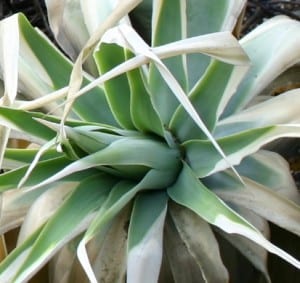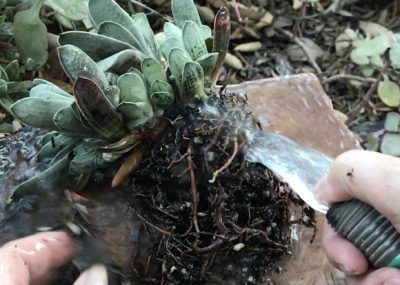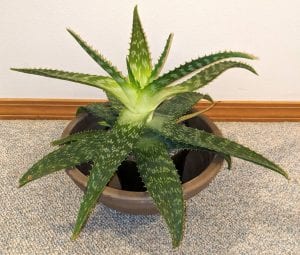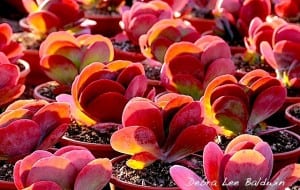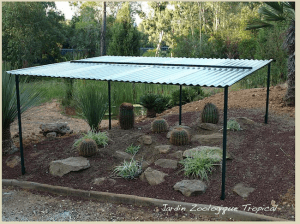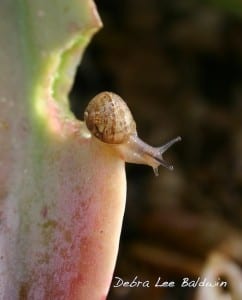Caring for Succulents
Prepare Your Succulents for Rainstorms
How to prepare succulents for rainstorms. Succulents, which come from arid climates, may rot. Stems or trunks turn squishy and collapse. It may be possible
Read MoreTina’s Tips & 16 Things Your Succulents Want You to Know
Expert succulent grower and Cactus & Succulent Society vendor Tina Zucker says “you don’t need to understand the science of plants. It’s all about observation, and anyone can do that.” 16 Things Your Succulents Want You to Know
Read MoreShould You Cut Echeveria Flowers?
Here and in my new video, “Should You Cut Echeveria Flowers?” I explain why you should snip echeveria bloom stalks, and how you and your plants both benefit.
Read MoreFrost and Succulents: What You Need to Know
Depending on how long temps stay below freezing (32 degrees F), “frost tender” succulents may show varying degrees of damage. When moisture in the cells of a vulnerable plant freezes, it expands, bursts cell walls, and turns leaves to mush. In a “light frost,” leaf tips alone may show damage (“frost burn”). In a “hard frost,” temps stay…
Read MoreOh No, My Succulents Froze!
Will your succulents recover from frost damage? It depends. Here’s how frost-tender succulents looked before temps dropped into the mid-20s F, and after: Euphorbias before frost Here’s the same Euphorbia ammak ‘Variegata, after the frost: Euphorbia ammak after frost Likelihood of recovery: Nil. Too much of the tissue was damaged. But what about the Euphorbia tirucalli ‘Sticks on Fire’ behind…
Read MoreCold Weather Care for Outdoor Succulents, By Region
Cold Weather Care for Outdoor Succulents, By Region Should you be worried about your outdoor succulents in winter? It depends on where you live. It’s all about frost. The temperature at which water freezes (32 degrees F) is the Great Divide. Above that, most succulents are fine. Below that, most are at risk. See “Frost and…
Read MoreAnts in Your Succulents? What to Do
Late summer into fall, Argentine ants like to nest in the root balls of potted plants. Haworthias, aloes (especially dwarf varieties), gasterias and gasteraloes are highly vulnerable. Ants overwinter in the soil and consume the plant’s juicy core. Leaves eventually fall off and the plant dies. Ants push soil up from below. The first line of defense is to…
Read MoreHow to Make Succulents Bloom
Above: The problem could be not enough sunlight. Is there a way to make succulents bloom? Yes and no. It partly depends on a plant’s age. It may not be large or mature enough to gear up for reproduction (which is the point of flowers). But there IS something you can do to make a…
Read MoreShould You Let Your Flapjack Plants Bloom?
Should you let your flapjack plants (Kalanchoe luciae) bloom? I’m recommending no…but it’s not that cut-and-dried. Flapjack plant is a succulent that’s popular mainly because of the color of its leaves. (Shown above at Waterwise Botanicals nursery.)f Like other succulents with overlapping leaves along a single stem, when Kalanchoe luciae blooms, the entire plant elongates. This is how those in my…
Read MoreSucculents and Too Much Rain, A French Solution
Want to protect your succulents from too much rain? Here’s how the Jardin Zoologique Tropical in southeastern France keeps their succulents from becoming waterlogged during seasonal rainstorms. Corrugated fiberglass panels atop metal bars tent the plants so excess rain doesn’t soak the soil. The structures are tall enough to allow good air circulation, and the panels are translucent, enabling maximum sunlight to reach the plants. The…
Read MorePrepare Your Succulents for Rainstorms
During rainy weather, succulents, which come from arid climates, may rot. Stems or trunks turn squishy and collapse. It may be possible to take cuttings from healthy top growth and restart the plants—as I did after one rainy winter with aeoniums. Fortunately, the rest of my succulents came through fine, despite double normal rainfall. After…
Read More



